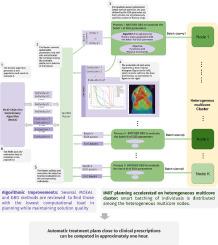通过算法改进和计算加速快速自动放疗计划
IF 6.2
2区 计算机科学
Q1 COMPUTER SCIENCE, THEORY & METHODS
Future Generation Computer Systems-The International Journal of Escience
Pub Date : 2025-09-25
DOI:10.1016/j.future.2025.108168
引用次数: 0
摘要
调强放射治疗通过动态调整靶肿瘤组织的光束强度来增强剂量传递,同时保留健康的器官。最有效的计划方法之一是使用广义等效均匀剂量度量,它确保了高质量的治疗计划,但需要为每个解剖结构调整几个超参数。传统上,这一过程是由临床专家手动执行的,这既耗时又依赖于人类的专业知识。为了解决这些问题,之前的方法将多目标进化搜索与基于梯度的优化相结合,实现了调优过程的自动化。然而,这种混合策略的计算成本很高,因为每个候选解决方案必须经过一个完整的基于梯度的优化步骤,在整个过程中重复数千次。本研究引入了两种互补策略来提高该框架的效率。首先,我们分析了更快收敛的备选多目标进化算法,从而减少了所需的函数评估次数,并比较了三种基于梯度的优化方法,以确定在不影响计划质量的情况下加速收敛的方法。其次,我们实现了一个并行计算框架,该框架使用适合每个节点计算能力的静态批调度策略,在异构多核计算集群之间分配功能评估。与原始实现相比,这些算法和计算增强的组合产生了4049的加速因子。因此,高质量的放疗治疗计划可以在大约一小时内自动生成,使这种方法能够整合到时间有限的临床工作流程中。本文章由计算机程序翻译,如有差异,请以英文原文为准。

Fast automatic radiotherapy planning via algorithmic improvements and computational acceleration
Intensity-Modulated Radiation Therapy enhances dose delivery by dynamically adjusting beam intensities to target tumorous tissues while preserving healthy organs. One of the most effective planning approaches uses the Generalized Equivalent Uniform Dose metric, which ensures high-quality treatment plans but requires tuning several hyperparameters for each anatomical structure. Traditionally, this process is performed manually by clinical experts, making it time-consuming and dependent on human expertise. To address these challenges, a previous method combined multi-objective evolutionary search with gradient-based optimization to automate the tuning process. However, this hybrid strategy incurs high computational cost, as each candidate solution must undergo a complete gradient-based optimization step, repeated thousands of times throughout the process. This study introduces two complementary strategies to improve the efficiency of this framework. First, we analyze alternative multi-objective evolutionary algorithms that converge more rapidly, thereby reducing the number of required function evaluations, and we compare three gradient-based optimization methods to identify the one that accelerates convergence without compromising plan quality. Second, we implement a parallel computing framework that distributes the function evaluations across heterogeneous multicore computing clusters using a static batch scheduling strategy adapted to each node’s computational capacity. Combined, these algorithmic and computational enhancements yield an acceleration factor of 4049 compared to the original implementation. As a result, high-quality radiotherapy treatment plans can be automatically generated in approximately one hour, making this approach viable for integration into time-constrained clinical workflows.
求助全文
通过发布文献求助,成功后即可免费获取论文全文。
去求助
来源期刊
CiteScore
19.90
自引率
2.70%
发文量
376
审稿时长
10.6 months
期刊介绍:
Computing infrastructures and systems are constantly evolving, resulting in increasingly complex and collaborative scientific applications. To cope with these advancements, there is a growing need for collaborative tools that can effectively map, control, and execute these applications.
Furthermore, with the explosion of Big Data, there is a requirement for innovative methods and infrastructures to collect, analyze, and derive meaningful insights from the vast amount of data generated. This necessitates the integration of computational and storage capabilities, databases, sensors, and human collaboration.
Future Generation Computer Systems aims to pioneer advancements in distributed systems, collaborative environments, high-performance computing, and Big Data analytics. It strives to stay at the forefront of developments in grids, clouds, and the Internet of Things (IoT) to effectively address the challenges posed by these wide-area, fully distributed sensing and computing systems.

 求助内容:
求助内容: 应助结果提醒方式:
应助结果提醒方式:


